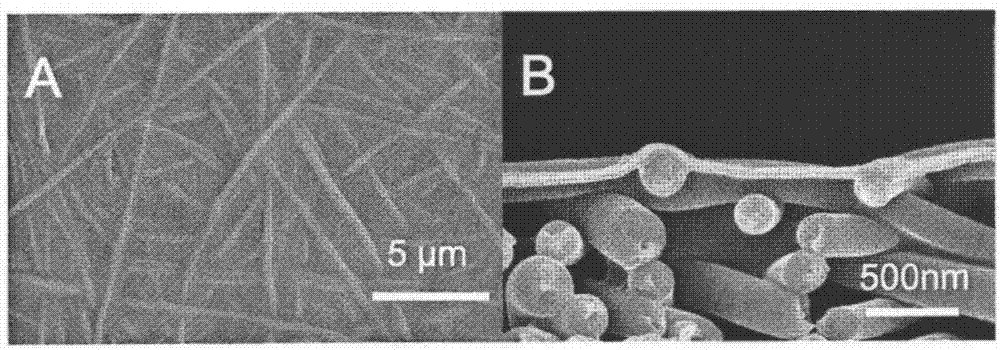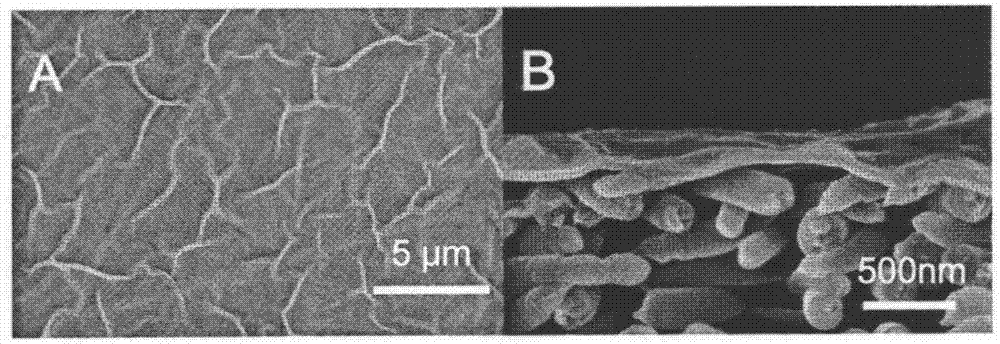Nano-fiber-based composite pervaporation membrane and preparation method thereof
A technology of nanofibers and pervaporation, applied in chemical instruments and methods, semi-permeable membrane separation, membranes, etc., can solve problems such as unfavorable polymerization of dense skin, damage to composite membrane structure, and difficulty in uniform deposition, achieving efficient and long-lasting organic solvents Effects of dehydration, enhanced stability, and enhanced separation performance
- Summary
- Abstract
- Description
- Claims
- Application Information
AI Technical Summary
Problems solved by technology
Method used
Image
Examples
Embodiment 1
[0033] A nanofiber-based pervaporation composite membrane is composed of a base layer, an intermediate transition layer and a surface layer. The base layer is a nanofiber porous support layer, the intermediate transition layer is a modified graphene oxide layer, and the surface layer is an interface polymerization active separation layer. The thickness of the surface layer is 40nm.
[0034] The preparation method of the above-mentioned nanofiber-based pervaporation composite membrane is as follows:
[0035] (1) Polypropylene (PAN) (M w =120,000g / mol, Jinshan Petrochemical) 8g was dissolved in 92g of N,N-dimethylformamide (DMF) solvent, and stirred at 40°C for 6h to obtain a transparent and uniform electrospinning solution.
[0036] (2) Add the electrospinning solution in step (1) into the syringe, and extrude under the control of a micro-injection pump. The nozzle of the syringe is connected to the high-voltage positive electrode. The electrospinning parameters are controlled...
Embodiment 2
[0043] A nanofiber-based pervaporation composite membrane is composed of a base layer, an intermediate transition layer and a surface layer. The base layer is a nanofiber porous support layer, the intermediate transition layer is a modified graphene oxide layer, and the surface layer is an interface polymerization active separation layer. The thickness of the surface layer is 80nm.
[0044] The preparation method of the above-mentioned nanofiber-based pervaporation composite membrane is as follows:
[0045] (1) polyacrylonitrile (PAN) (M w =120,000g / mol, Jinshan Petrochemical) 8g was dissolved in N,N. dimethylformamide (DMF) solvent 92g, and stirred at 40°C for 6h to obtain a transparent and uniform electrospinning solution.
[0046] (2) Add the electrospinning solution in step (1) into the syringe, and extrude under the control of a micro-injection pump. The nozzle of the syringe is connected to the high-voltage positive electrode. The electrospinning parameters are controll...
Embodiment 3
[0053] A nanofiber-based pervaporation composite membrane is composed of a base layer, an intermediate transition layer and a surface layer. The base layer is a nanofiber porous support layer, the intermediate transition layer is a modified graphene oxide layer, and the surface layer is an interface polymerization active separation layer. The thickness of the surface layer is 60nm.
[0054] The preparation method of the above-mentioned nanofiber-based pervaporation composite membrane is as follows:
[0055] (1) polyacrylonitrile (PAN) (M w =120,000g / mol, Jinshan Petrochemical) 8g was dissolved in 92g of N,N-dimethylformamide (DMF) solvent, and stirred at 40°C for 6h to obtain a transparent and uniform electrospinning solution.
[0056] (2) Add the electrospinning solution in step (1) into the syringe, and extrude under the control of a micro-injection pump. The nozzle of the syringe is connected to the high-voltage positive electrode. The electrospinning parameters are contro...
PUM
 Login to View More
Login to View More Abstract
Description
Claims
Application Information
 Login to View More
Login to View More - R&D
- Intellectual Property
- Life Sciences
- Materials
- Tech Scout
- Unparalleled Data Quality
- Higher Quality Content
- 60% Fewer Hallucinations
Browse by: Latest US Patents, China's latest patents, Technical Efficacy Thesaurus, Application Domain, Technology Topic, Popular Technical Reports.
© 2025 PatSnap. All rights reserved.Legal|Privacy policy|Modern Slavery Act Transparency Statement|Sitemap|About US| Contact US: help@patsnap.com


